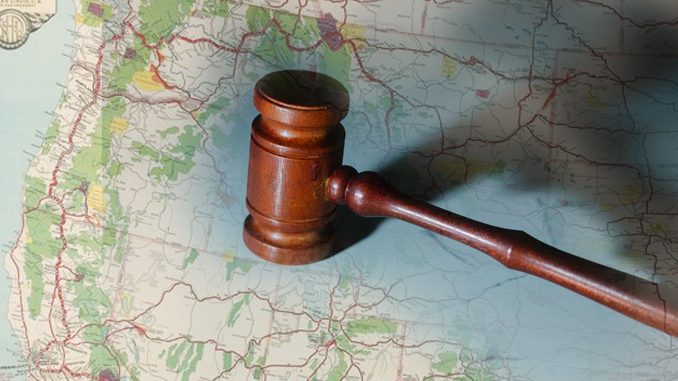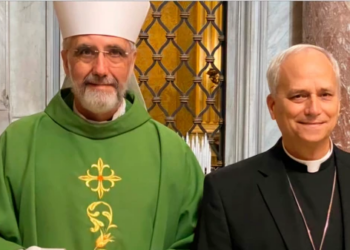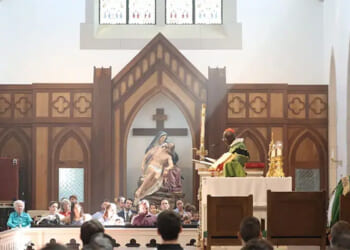
June 1, 2025, marks the 100th anniversary of the Supreme Court’s decision in Pierce v. Society of Sisters (268 US 510).
What’s that, you ask? And why should I care?
Pierce was a unanimous Supreme Court ruling that struck an initial blow for parents’ rights. It’s a precedent on which we should build, because parental rights are under attack, especially in school settings.
In 1922, Oregon voters adopted by referendum a law requiring all children between eight and 16 to go to a public school. Many states have compulsory education laws requiring mandatory school attendance for children of certain ages. Oregon went one step further: the only school meeting compulsory education requirements was the public school. Parents who didn’t send their offspring there were guilty of a misdemeanor for not providing their child with appropriate schooling.
An order of Catholic nuns, acting under their corporate legal identity as the “Society of Sisters of the Holy Names of Jesus and Mary,” brought suit to declare the provision unconstitutional.
The Supreme Court agreed. Unanimously.
On this centennial anniversary, let’s take a closer look at Pierce and how it might be relevant for today (up-front caveat: I am not a lawyer).
The Question
Supreme Court decisions normally seek to answer a legal question: Does X violate Y? In Pierce, the Court asked whether Oregon’s law “violate[d] the liberty of parents to direct the education of their children?” Its answer: Yes!
The child is not the mere creature of the state; those who nurture him and direct his destiny have the right, coupled with the high duty, to recognize and prepare him for additional obligations. (268 US 535)
“Additional obligations” like life. Like eternal life. We cannot exclude that the Court reckoned with parents wanting to prepare children even for the later when we remember this is a case about being able to attend a parochial school where such religious considerations were part of the curriculum.
The fundamental theory of liberty upon which all governments in this Union repose excludes any general power of the State to standardize its children by forcing them to accept instruction from public teachers only. (268 US 535)
Those two quotations need to be read together because they provide very fertile grounds for the further evolution of parental rights in education. The first makes clear that parents have both “right” and “duty” to educate their child, who is not “a mere creature” of the state. The second further constrains state ambitions by making clear its power vis-à-vis a child is limited: the state cannot homogenize education by forcing children only into public schools.
The Court approvingly cited its own 1923 precedent, Meyer v. Nebraska. In that case, the Court struck down a Nebraska law, adopted in the wake of World War I, prohibiting the teaching of modern foreign languages. It justified the ruling by insisting the Constitution banned what “unreasonably interferes with the liberty of parents and guardians to direct the upbringing and education of children” (Pierce at 534).
Speaking of rights and parents
It’s curious that the plaintiffs who brought this and a parallel case were a congregation of nuns (celibate women without children) and a boys’ high school military academy. No parent appears to have sued Oregon.
That’s unusual because, normally, the party bringing a suit has to be able to show real rights at stake. Parents with children who wanted to send their child to a parochial school seem the most logical plaintiffs, especially because they’d be convicted of a misdemeanor.
But maybe that wasn’t so unusual, after all. In the 1920s, many Catholics in the United States were immigrants. Whether that was specifically true of Oregon, I do not know, but the demographic profile of the overall cohort suggested they were not the usual suspects to bring Constitutional lawsuits.
Religious sisters suing, on the other hand, raised other issues. What rights did they have at stake? The Court (in keeping with its conservative makeup and the economic tenor of the Roaring Twenties) focused on property rights: the compulsory school law would put the “Society” out of the education business, saddling them with property and perhaps long-term contracts.
Another issue in Supreme Court cases is that there is an actual “case and controversy.” The Supreme Court does not take hypothetical cases or issue advisory opinions. Oregonians had adopted the compulsory public school act in 1922 to go into effect in 1926; thus, nobody had yet been forced into a public school under it. If the Court wanted to sidestep the case, as it might today, it might have punted the decision.
But it recognized that the plaintiffs’ “interest was clear and immediate” and so took/decided the case. It linked up those interests with parents by noting the lower court had found “the right to conduct schools was property, and that parents and guardians, as part of their liberty, might direct the education of children by selecting reputable teachers and places. Also, that these schools were not unfit or harmful to the public, and that enforcement of the challenged statute would unlawfully deprive them of patronage, and thereby destroy their owners’ business and property” (268 US 534).
So, the nuns’ property interest in running a school was married to parents’ general right to control their child’s education to strike down Oregon’s never-enforced statute.
Reflections on rights
As a theologian (and, again, not a lawyer), I am suspicious when claims of different kinds of rights get blended together. Why? Because I fear that in such hybrid claims, full articulation of religious freedom rights is often muted.
Pierce is built on parental rights, but parental rights to what? The case emphasizes parental rights to control a child’s education, an important consideration to which the Court afforded a strong defense. But what about parental rights (and even nuns’ rights) to free exercise of religion? Free exercise of religion means your right not just to believe but to do things–such as teach–motivated and infused by religion.
I am not downplaying the Court’s vigorous defense of parental rights in education. One hundred years later, this remains contested. The Supreme Court will probably decide Mahmoud v. Taylor in June, focused on how parent rights intersect with a Maryland county’s refusal to let them withdraw children from its gender-infused sex education curriculum. The trajectory of Pierce is potentially strongly supportive of an expansive approach to parental rights in education. I want to keep that trajectory on target.
While Pierce potentially provides strongly supportive of parental rights, it also contains enough leeway to temper an expansive approach to parental education rights. The Court forbade too great a standardization of state standards in schooling. But what is “too great?” Who establishes the balances between when a state is using schools to advance a social common good versus the “right and duty of parents to direct the education of their children?” Are there shifting standards in this area? If you doubt that, consider: one hundred years ago, would the Pierce court have even countenanced schools teaching, over parental objection, how to apply “birth control”?
Pierce strongly supports parental rights but doesn’t define (at least not clearly) how far those rights go when “balanced” against state interests in education. Catholic social doctrine would go further: parents are not just one party with “rights” to be balanced against the state. Parents have primacy of rights in the education of their children. Families preexist the state. Schools of any kind–state or otherwise–exist to support parents in their educational responsibilities, but they remain subordinate to parents. Catholics should never buy into the contemporary pedagogical jargon that regards parents and schools as equal “partners” in a child’s education. It’s the logic that justifies public schools concealing information from parents themselves about “gender transitioning” and “renaming” of children in school.
Another reason I resist the “hybrid” or “combined” approach to rights claims in such cases is that they seem to temper or downplay a robust application of free exercise of religion rights. As I noted, Pierce doesn’t explicitly talk about First Amendment free exercise rights, something I think would have strengthened the decision and strengthened overall religious freedom jurisprudence.
Why should we enhance religious freedom jurisprudence? Consider the recent law adopted by Colorado which, among other things, treats a parent’s failure to “affirm” transgenderism as a criterion to use against that parent in child protection and/or custody disputes. Some parents have already filed suit against the Centennial State, claiming the law violates their “free speech” rights by compelling them to support positions they do not. The fact that First Amendment “freedom of speech” jurisprudence seems more robust than “free exercise” case law should be concerning.
After all, if we affirm parents’ rights to determine their child’s education–especially if we affirm the primacy of parental rights–then those rights will stand on even firmer ground if backed by religious freedom. But if we treat them as a matter of speech, then it seems to become a competition between “parent speech” and “school/state speech.” The problem with that paradigm is that it appears to shift the focus from the parent to the child. Instead of the parent defining a minor’s education and upbringing, the focus moves to the child for whose attention different parties–parent versus child–compete in the ‘marketplace of ideas.”
The notion that the child decides from a buffet of ideas eventually destroys parental rights over minors and plays into the state’s hands. Consider that, at a time parents are claiming their rights to homeschool against state educational indoctrination, homeschooling opponents argue it should be outlawed because parents “monopol(ize)” the inculcation of their child’s values, values that may be “counter to those of the larger society.”
In other words, if you don’t teach your children to appreciate the dictatorship of relativism, you’re a bad parent.
Pierce was a start to parental rights. It said parents could not be forced to use only public schools. I’m certain that considerable parts of the public school establishment think the case was wrongly decided. But it’s a limited victory. The Court’s love affair with secularism and “separation of Church and state,” starting in the late 1940s, minimized the impact of Pierce’s parental rights: you won’t be forced to send your kid to public schools but you will be forced to pay twice (taxes and tuition) if you choose to exercise those rights off the public school plantation. Pierce banned a public school monopoly, but subsequent rulings left behind an equally impactful public school funding monopoly.
The real end of parental rights in education would be recognition that education—not schools, but education—exist for children. If education is for children, why isn’t the money? Why do educational dollars not go to the beneficiaries but to a venue? Children and their parents should be free, without financial disability, to choose whatever educational arrangement the child best thrives in. That is the logical conclusion of Pierce’s parental rights … if we could get beyond cramped judicial perspectives on free exercise/separation issues. Let’s work, through legislation and lawfare, to get it there.
One hundred years after Pierce, we should recognize that the Supreme Court once gave us the opening for a strong assertion of parental rights. We need to cultivate it and pair it with an equally robust assertion of free exercise of religion rights. Otherwise, we will continue to oscillate between Catholic social thought’s focus on the primacy of parental rights versus concepts of parental rights in competition with the state’s claim to substitute its values in loco parentis, the outcome dependent on who can cobble together five judges out of nine.
If you value the news and views Catholic World Report provides, please consider donating to support our efforts. Your contribution will help us continue to make CWR available to all readers worldwide for free, without a subscription. Thank you for your generosity!
Click here for more information on donating to CWR. Click here to sign up for our newsletter.










